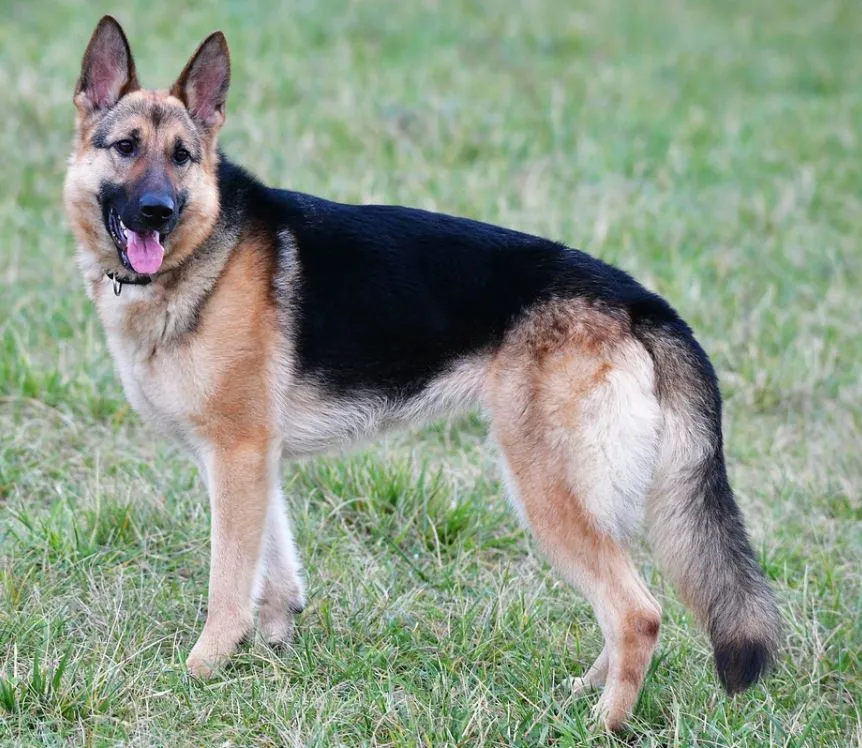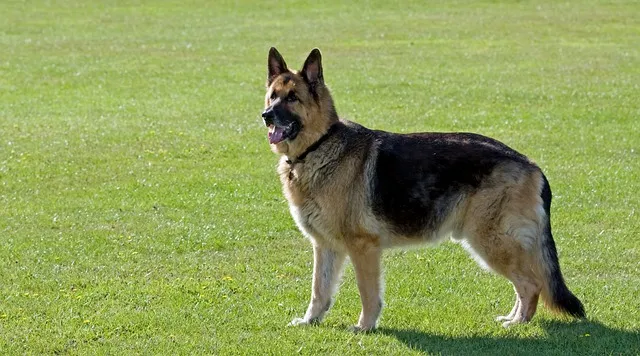German shepherds are loyal, intelligent, protective, and athletic breeds. Originally bred for herding sheep, they have excellent guarding abilities as well as being highly active and in great physical shape.
Unfortunately, their active lifestyle is sometimes put on hold, due to joint problems, one being hip dysplasia.
The Orthopedic Foundation of Animals estimates that close to 19% of German shepherds will suffer from hip dysplasia.
Contained in this post is information about what hip dysplasia is,

For your dog’s vitamin supplement, food, toys, or other dogs product please visit the Sundays for dogs website.
Hip Dysplasia and How It Develops
Hip dysplasia is most often a hereditary and congenital condition that can plague any breed of dog but is usually found in large breeds such as Saint Bernard, Great Dane, Labrador retriever, and German shepherd.
This disorder can be inherited from the parents and is one reason for using a reputable breeder. Good breeders do not breed animals with known genetic disorders.
Functioning hip joints have a hip socket and a ball on the femur which fits well in the socket making for smooth, fluid movement.
When hip dysplasia occurs, the hip socket and femur ball do not fit properly due to a deformity of the ball, causing grinding and rubbing. This, in turn, will cause the wearing down of cartilage resulting in friction with pain and the eventual deterioration of the joint.
Hip dysplasia can develop even as puppies and can occur even if the parents are clear from a disposition to it. German shepherd Puppies are extremely active and although exercise is good for your pup, overdoing it when bones and joints are still forming can initiate medical issues.
Any kind of hip injury as a puppy can cause hip dysplasia to develop and in an adult prompt a hereditary form of dysplasia to accelerate rapidly.
To ensure in part that the German shepherd puppy you get from your breeder is clear on the breeding end for hip dysplasia, you should make sure your breeder has certified the hips of both the mother and the father.
This would have involved hip x-rays of both parents after the age of two. If there were no signs of hip dysplasia on the x-rays, puppies should not develop dysplasia, although unfortunately, it can skip a generation. You may need to check back further into your breeder’s records if they are available.
To check your shepherds’ health status or their DNA checks, please visit the Embark vet website for all the help you may need.
Symptoms of Hip Dysplasia in dogs
Hip dysplasia can show symptoms when your German shepherd is around two years old unless it is caused by an injury as a puppy.
X-rays can detect it at this time and veterinarians are pretty diligent about checking German shepherds for this as they get older.
Hip dysplasia can occur in one or both hips and the hereditary form is more common in the left hip.
Although hip dysplasia is incurable, it is best that your pup receive early treatment to reduce pain. The following are symptoms to be on the lookout for.
- Limping
- Hopping like a bunny
- A gait that is unsteady
- Standing up and lying down is difficult
- Hesitance to play, run or climb stairs
- Lethargy
- Activity level decreases
- Possible aggression when touching their hip due to pain
- Crying or whining

Treatment For Hip Dysplasia
There is no cure for hip dysplasia once you get the diagnosis. There are treatments but keep in mind that treatment should begin with the first symptoms and diagnosis.
As your shepherd gets older and symptoms worsen, treating the condition becomes more difficult. Below are some treatment options.
Exercise
You are probably thinking that if your shepherd is in pain, how are they going to exercise? This doesn’t mean it will be crazy exercise. It will be a form of physical therapy and your veterinarian will give you a plan with dos and don’ts.
Walking, not running along with swimming are two good choices. Swimming is an excellent form of exercise that doesn’t put a strain on joints.
Hydrotherapy is often suggested because during water exercises the body is buoyant, thus being supported. “Water healing” is actually the meaning of hydrotherapy in Greek.
Diet
Diet is very important so your German shepherd gets proper nutrition but does not gain weight by being less active and consuming fewer calories at the same time. Any weight gained would put an added strain on joints.
Medication
Different NSAIDs or non-steroidal anti-inflammatory drugs may be used to control inflammation that causes pain.
Supplements
Supplements such as glucosamine and chondroitin may be recommended by your shepherd’s veterinarian. Glucosamine helps joints while chondroitin can repair cartilage.
Often supplements contain both of these along with a mixture of other supplements and sometimes herbs or spices such as turmeric which has been proven to reduce both inflammation and pain. These can also give you a more natural alternative to treatment.
Flooring
If you have slippery floors, especially when wet, consider adding some non-slip carpets or carpeting. This is a big cause of jarred joints in pets from slipping and sliding on floors.
Surgery
There are a few surgical options to treat hip dysplasia if mobility is low and pain becomes unbearable.
Corrective surgery by removing the upper part of the femur can help but a hip replacement may be recommended when hip dysplasia is severe.
Corrective surgery can range from $1700 to $4500, while hip replacement surgery may be from $3500 to $7000. Prices can vary depending on how in-depth the surgery is and even the location where you live.
Although a high price to pay, if hip replacement is a success, about 90% of German shepherds live without pain.
Stem cell therapy
A new and exciting treatment that is now an option in some areas is stem cell therapy. This can repair tissue and replace damaged or dead cells. This has the potential to be a real breakthrough in hip dysplasia treatment as well as for other diseases.
Wheelchair
If your German shepherd really begins to struggle with mobility there is such a product as a dog wheelchair. This would give your pup support and enables them to walk and move without the use of their hind legs.

Hip Dysplasia Life Expectancy
A German shepherd’s life expectancy ranges from twelve to fifteen years. Hip dysplasia, although incurable, does not always have a derogatory impact on life expectancy.
If your German shepherd is kept comfortable with any of the treatments above, it can live a long life. Often though, treatments such as the continual use of NSAIDs can have an impact on your shepherd’s health in a negative way.
The NSAIDs will control pain but they can cause side effects such as high blood pressure, stomach, kidney, and heart problems, and conditions.
You may have to decide at some point as to what their quality of life is like and make the decision for euthanasia.
In conclusion, hip dysplasia may not affect your German shepherd’s life expectancy, but it can have a big impact on its quality of life.
A few things you can do to prevent hip dysplasia because it is so prevalent in German shepherds is to one, seek out a reputable breeder…
Give your puppy a nutritious diet with just the right amount of calories so they don’t pack on any extra weight before their hips are fully developed.
Although puppies are exuberant and playful, try to tone down jumping especially jumping out of a high car or truck.
Lift them out instead until bones are fully formed. Lastly, keep an eye out for signs and German shepherd hip dysplasia symptoms so treatment can begin early.
Hopefully, hip dysplasia will not affect your German shepherd’s life at all, but being prepared and recognizing the signs will be half the battle if it should occur.